Curriculum Theory and Practice: Reflection and Application Essay
VerifiedAdded on 2023/04/25
|8
|1594
|439
Essay
AI Summary
This essay delves into curriculum theory through three distinct parts. The first part involves a reflection on 'The Saber-Tooth Curriculum,' discussing initial impressions, questions raised, and overall viewpoints on the education system's flaws. The second part focuses on the application of curriculum theory, exploring the knowledge, skills, and dispositions students should acquire in school, emphasizing critical thinking, communication, adaptability, and technology integration. It also highlights the importance of teamwork, emotional understanding, and project-based learning. The final part provides an exit ticket defining 'curriculum' with references to academic articles, covering its various types (written, taught, tested; explicit, hidden, null) and its role in developing students' academic, professional, and personal skills. The essay concludes by emphasizing the curriculum's function as a guide for teachers and a standard for student performance.
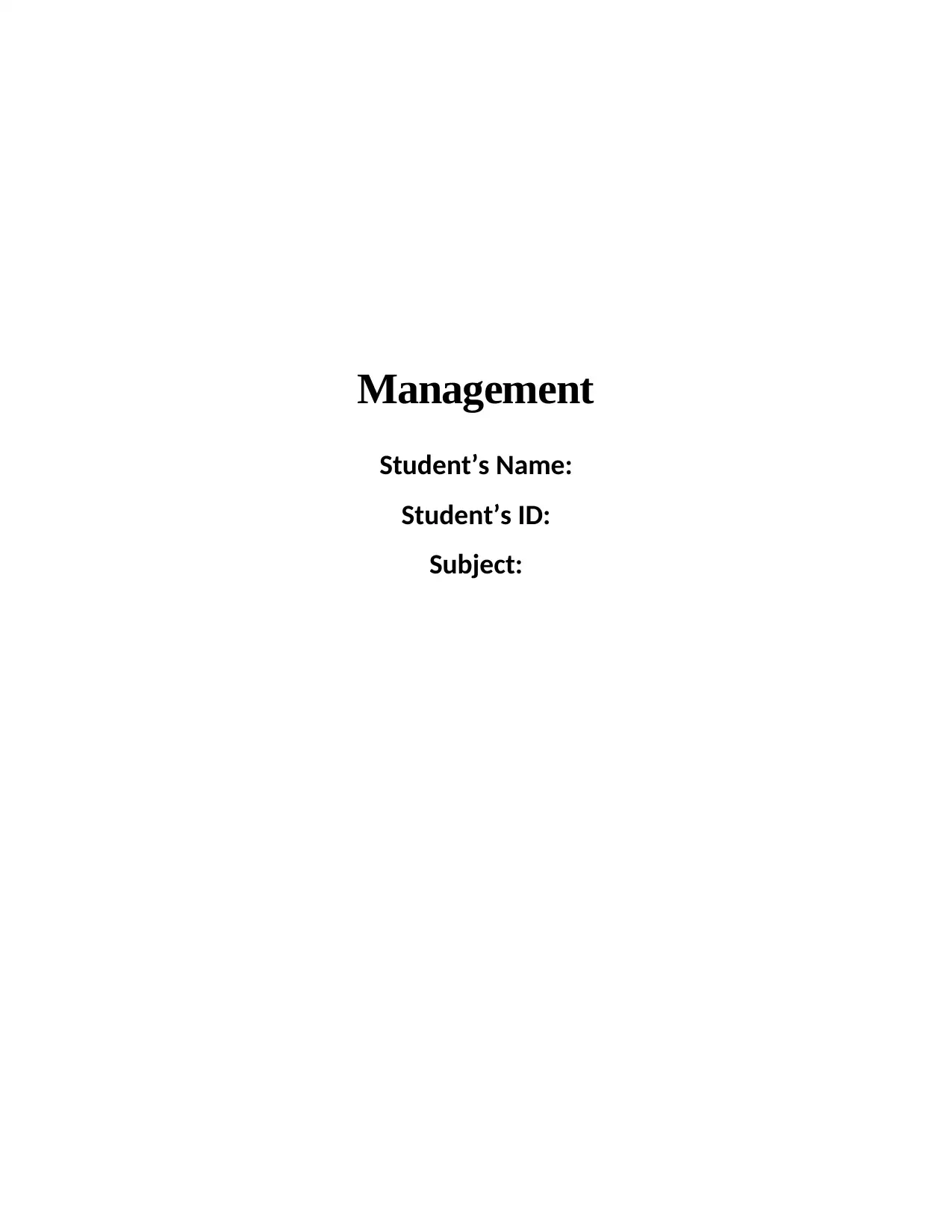
Management
Student’s Name:
Student’s ID:
Subject:
Student’s Name:
Student’s ID:
Subject:
Paraphrase This Document
Need a fresh take? Get an instant paraphrase of this document with our AI Paraphraser
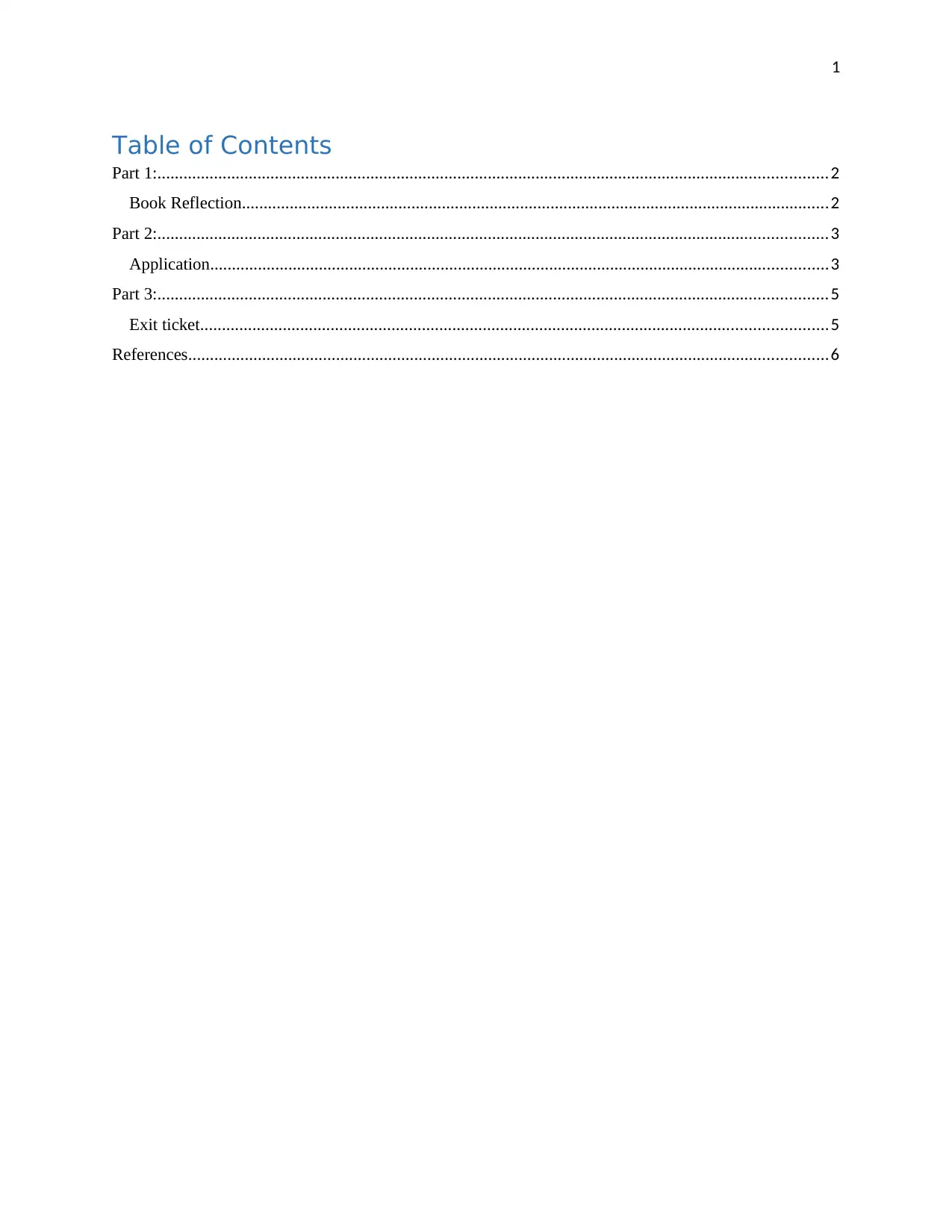
1
Table of Contents
Part 1:..........................................................................................................................................................2
Book Reflection.......................................................................................................................................2
Part 2:..........................................................................................................................................................3
Application..............................................................................................................................................3
Part 3:..........................................................................................................................................................5
Exit ticket................................................................................................................................................5
References...................................................................................................................................................6
Table of Contents
Part 1:..........................................................................................................................................................2
Book Reflection.......................................................................................................................................2
Part 2:..........................................................................................................................................................3
Application..............................................................................................................................................3
Part 3:..........................................................................................................................................................5
Exit ticket................................................................................................................................................5
References...................................................................................................................................................6
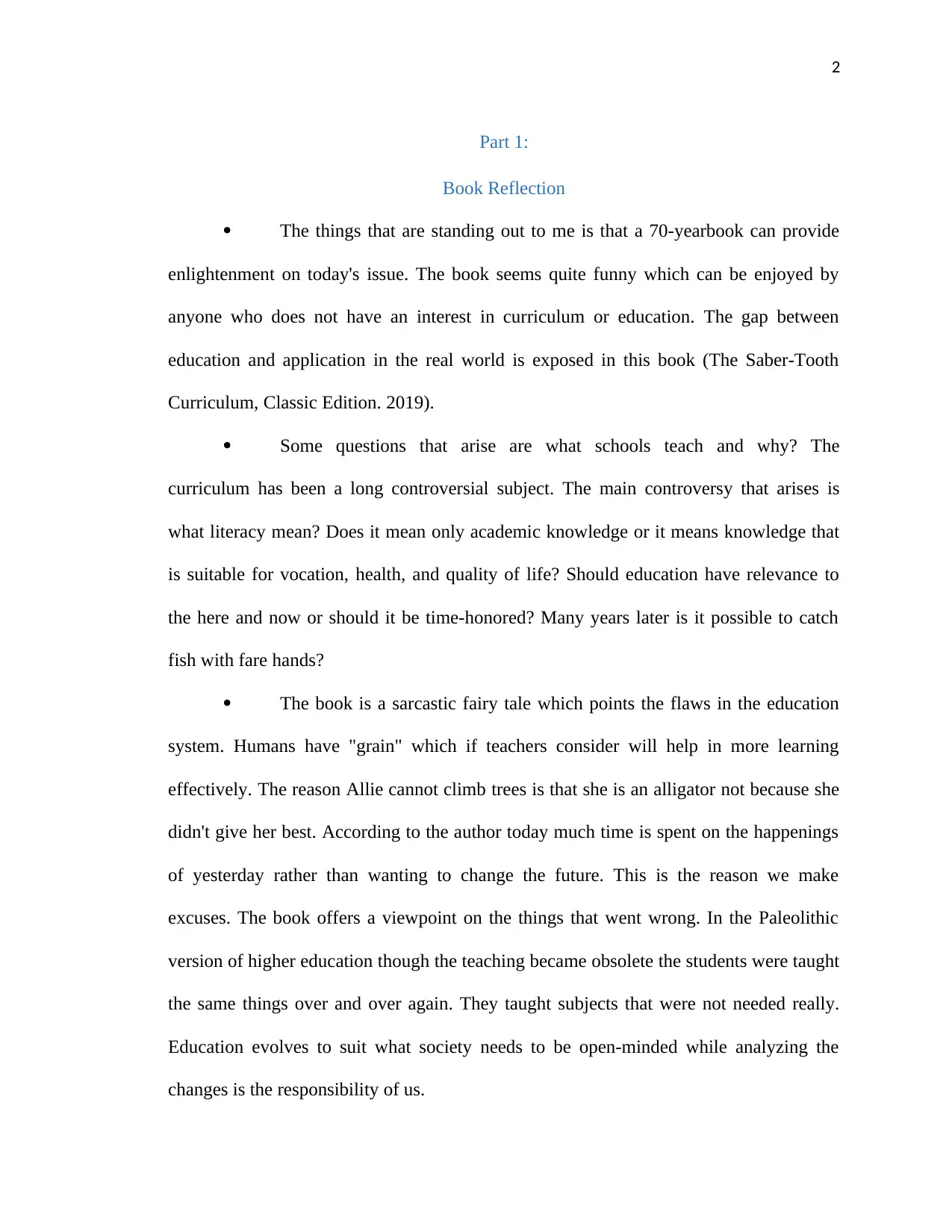
2
Part 1:
Book Reflection
The things that are standing out to me is that a 70-yearbook can provide
enlightenment on today's issue. The book seems quite funny which can be enjoyed by
anyone who does not have an interest in curriculum or education. The gap between
education and application in the real world is exposed in this book (The Saber-Tooth
Curriculum, Classic Edition. 2019).
Some questions that arise are what schools teach and why? The
curriculum has been a long controversial subject. The main controversy that arises is
what literacy mean? Does it mean only academic knowledge or it means knowledge that
is suitable for vocation, health, and quality of life? Should education have relevance to
the here and now or should it be time-honored? Many years later is it possible to catch
fish with fare hands?
The book is a sarcastic fairy tale which points the flaws in the education
system. Humans have "grain" which if teachers consider will help in more learning
effectively. The reason Allie cannot climb trees is that she is an alligator not because she
didn't give her best. According to the author today much time is spent on the happenings
of yesterday rather than wanting to change the future. This is the reason we make
excuses. The book offers a viewpoint on the things that went wrong. In the Paleolithic
version of higher education though the teaching became obsolete the students were taught
the same things over and over again. They taught subjects that were not needed really.
Education evolves to suit what society needs to be open-minded while analyzing the
changes is the responsibility of us.
Part 1:
Book Reflection
The things that are standing out to me is that a 70-yearbook can provide
enlightenment on today's issue. The book seems quite funny which can be enjoyed by
anyone who does not have an interest in curriculum or education. The gap between
education and application in the real world is exposed in this book (The Saber-Tooth
Curriculum, Classic Edition. 2019).
Some questions that arise are what schools teach and why? The
curriculum has been a long controversial subject. The main controversy that arises is
what literacy mean? Does it mean only academic knowledge or it means knowledge that
is suitable for vocation, health, and quality of life? Should education have relevance to
the here and now or should it be time-honored? Many years later is it possible to catch
fish with fare hands?
The book is a sarcastic fairy tale which points the flaws in the education
system. Humans have "grain" which if teachers consider will help in more learning
effectively. The reason Allie cannot climb trees is that she is an alligator not because she
didn't give her best. According to the author today much time is spent on the happenings
of yesterday rather than wanting to change the future. This is the reason we make
excuses. The book offers a viewpoint on the things that went wrong. In the Paleolithic
version of higher education though the teaching became obsolete the students were taught
the same things over and over again. They taught subjects that were not needed really.
Education evolves to suit what society needs to be open-minded while analyzing the
changes is the responsibility of us.
⊘ This is a preview!⊘
Do you want full access?
Subscribe today to unlock all pages.

Trusted by 1+ million students worldwide
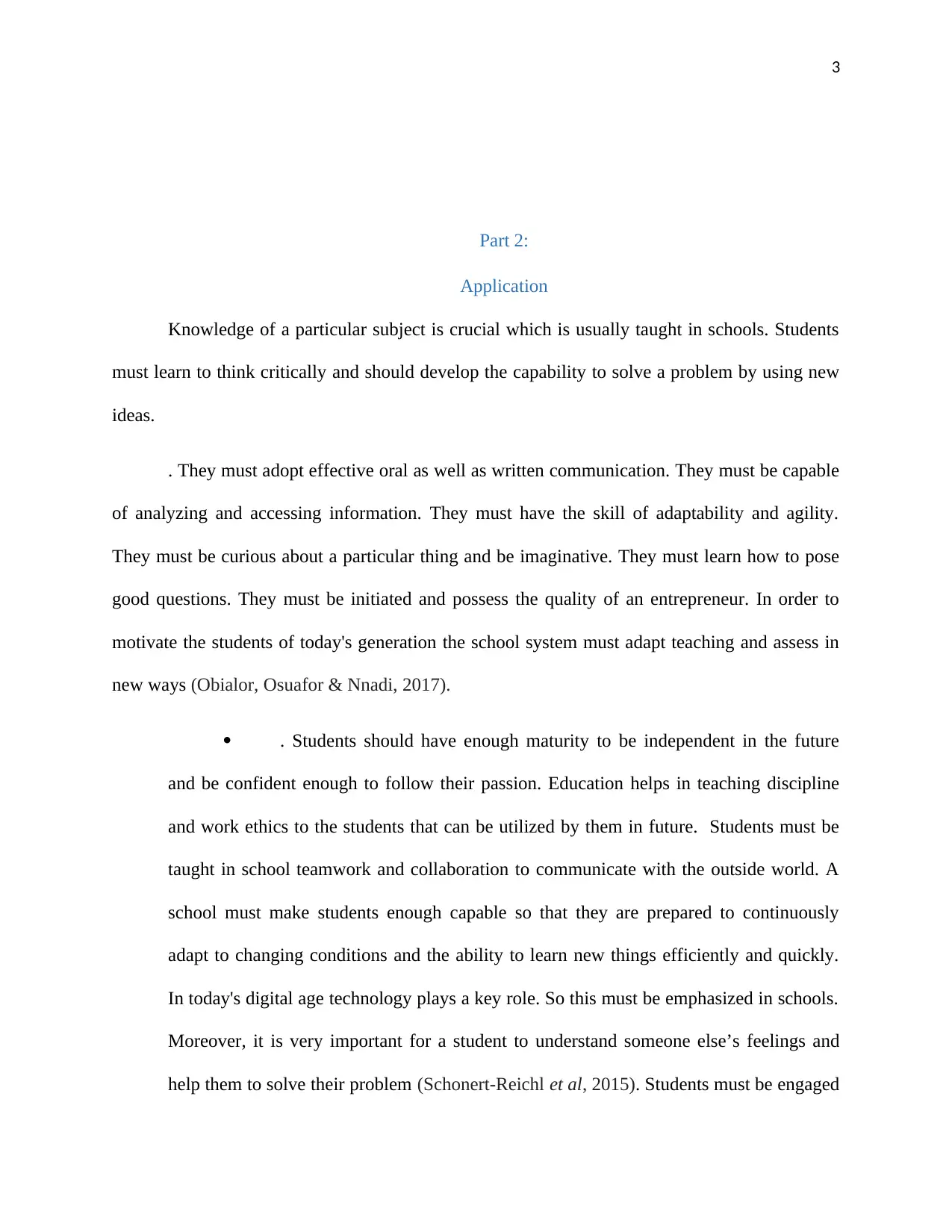
3
Part 2:
Application
Knowledge of a particular subject is crucial which is usually taught in schools. Students
must learn to think critically and should develop the capability to solve a problem by using new
ideas.
. They must adopt effective oral as well as written communication. They must be capable
of analyzing and accessing information. They must have the skill of adaptability and agility.
They must be curious about a particular thing and be imaginative. They must learn how to pose
good questions. They must be initiated and possess the quality of an entrepreneur. In order to
motivate the students of today's generation the school system must adapt teaching and assess in
new ways (Obialor, Osuafor & Nnadi, 2017).
. Students should have enough maturity to be independent in the future
and be confident enough to follow their passion. Education helps in teaching discipline
and work ethics to the students that can be utilized by them in future. Students must be
taught in school teamwork and collaboration to communicate with the outside world. A
school must make students enough capable so that they are prepared to continuously
adapt to changing conditions and the ability to learn new things efficiently and quickly.
In today's digital age technology plays a key role. So this must be emphasized in schools.
Moreover, it is very important for a student to understand someone else’s feelings and
help them to solve their problem (Schonert-Reichl et al, 2015). Students must be engaged
Part 2:
Application
Knowledge of a particular subject is crucial which is usually taught in schools. Students
must learn to think critically and should develop the capability to solve a problem by using new
ideas.
. They must adopt effective oral as well as written communication. They must be capable
of analyzing and accessing information. They must have the skill of adaptability and agility.
They must be curious about a particular thing and be imaginative. They must learn how to pose
good questions. They must be initiated and possess the quality of an entrepreneur. In order to
motivate the students of today's generation the school system must adapt teaching and assess in
new ways (Obialor, Osuafor & Nnadi, 2017).
. Students should have enough maturity to be independent in the future
and be confident enough to follow their passion. Education helps in teaching discipline
and work ethics to the students that can be utilized by them in future. Students must be
taught in school teamwork and collaboration to communicate with the outside world. A
school must make students enough capable so that they are prepared to continuously
adapt to changing conditions and the ability to learn new things efficiently and quickly.
In today's digital age technology plays a key role. So this must be emphasized in schools.
Moreover, it is very important for a student to understand someone else’s feelings and
help them to solve their problem (Schonert-Reichl et al, 2015). Students must be engaged
Paraphrase This Document
Need a fresh take? Get an instant paraphrase of this document with our AI Paraphraser
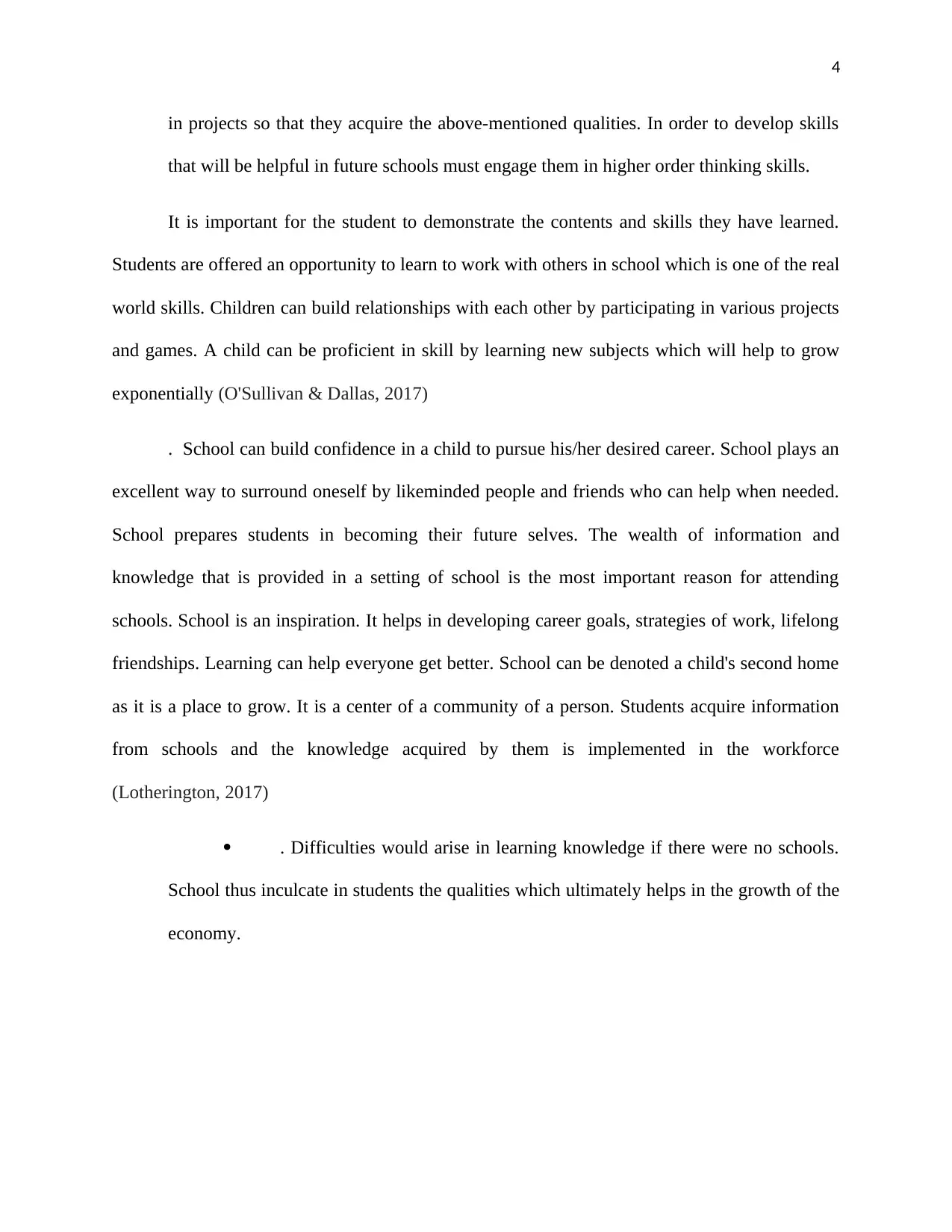
4
in projects so that they acquire the above-mentioned qualities. In order to develop skills
that will be helpful in future schools must engage them in higher order thinking skills.
It is important for the student to demonstrate the contents and skills they have learned.
Students are offered an opportunity to learn to work with others in school which is one of the real
world skills. Children can build relationships with each other by participating in various projects
and games. A child can be proficient in skill by learning new subjects which will help to grow
exponentially (O'Sullivan & Dallas, 2017)
. School can build confidence in a child to pursue his/her desired career. School plays an
excellent way to surround oneself by likeminded people and friends who can help when needed.
School prepares students in becoming their future selves. The wealth of information and
knowledge that is provided in a setting of school is the most important reason for attending
schools. School is an inspiration. It helps in developing career goals, strategies of work, lifelong
friendships. Learning can help everyone get better. School can be denoted a child's second home
as it is a place to grow. It is a center of a community of a person. Students acquire information
from schools and the knowledge acquired by them is implemented in the workforce
(Lotherington, 2017)
. Difficulties would arise in learning knowledge if there were no schools.
School thus inculcate in students the qualities which ultimately helps in the growth of the
economy.
in projects so that they acquire the above-mentioned qualities. In order to develop skills
that will be helpful in future schools must engage them in higher order thinking skills.
It is important for the student to demonstrate the contents and skills they have learned.
Students are offered an opportunity to learn to work with others in school which is one of the real
world skills. Children can build relationships with each other by participating in various projects
and games. A child can be proficient in skill by learning new subjects which will help to grow
exponentially (O'Sullivan & Dallas, 2017)
. School can build confidence in a child to pursue his/her desired career. School plays an
excellent way to surround oneself by likeminded people and friends who can help when needed.
School prepares students in becoming their future selves. The wealth of information and
knowledge that is provided in a setting of school is the most important reason for attending
schools. School is an inspiration. It helps in developing career goals, strategies of work, lifelong
friendships. Learning can help everyone get better. School can be denoted a child's second home
as it is a place to grow. It is a center of a community of a person. Students acquire information
from schools and the knowledge acquired by them is implemented in the workforce
(Lotherington, 2017)
. Difficulties would arise in learning knowledge if there were no schools.
School thus inculcate in students the qualities which ultimately helps in the growth of the
economy.
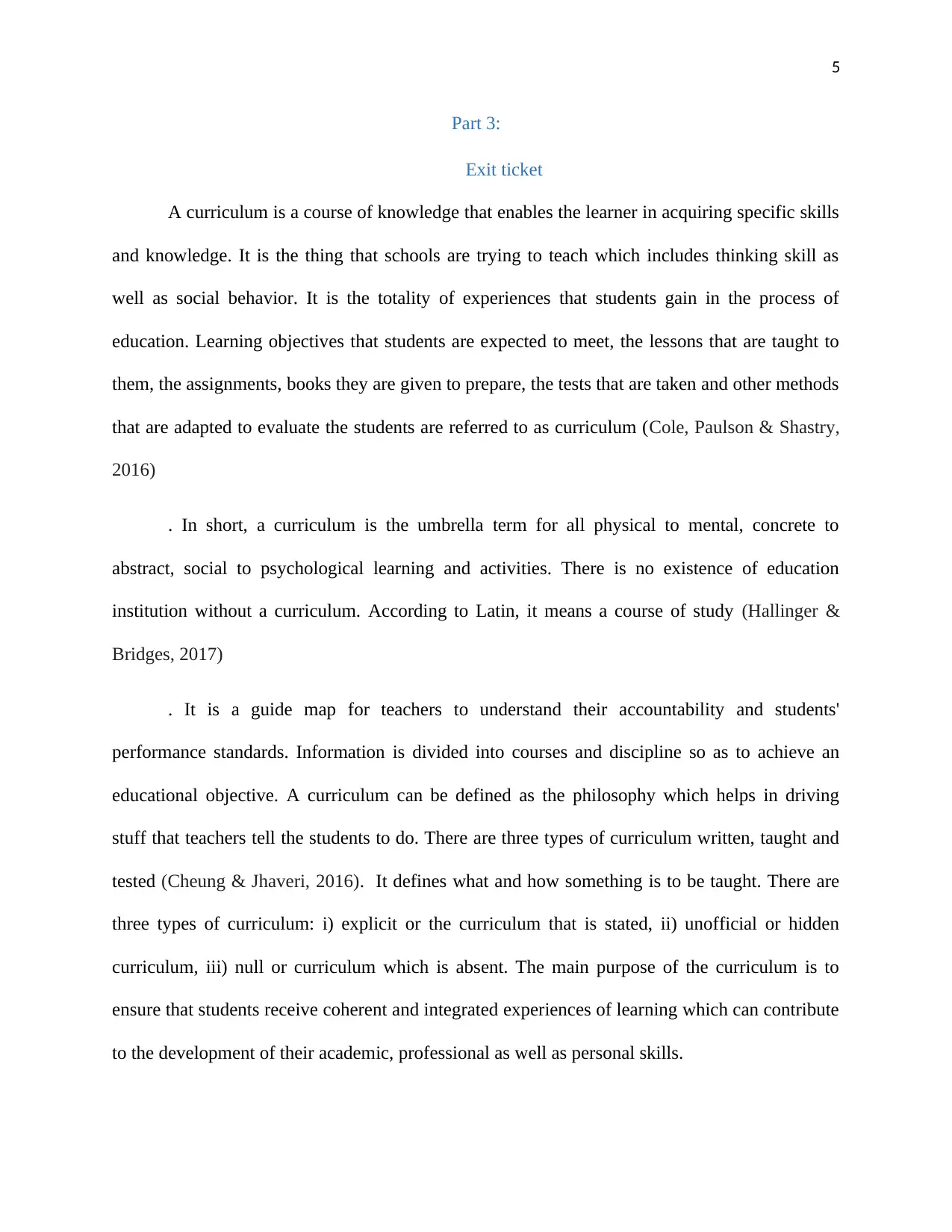
5
Part 3:
Exit ticket
A curriculum is a course of knowledge that enables the learner in acquiring specific skills
and knowledge. It is the thing that schools are trying to teach which includes thinking skill as
well as social behavior. It is the totality of experiences that students gain in the process of
education. Learning objectives that students are expected to meet, the lessons that are taught to
them, the assignments, books they are given to prepare, the tests that are taken and other methods
that are adapted to evaluate the students are referred to as curriculum (Cole, Paulson & Shastry,
2016)
. In short, a curriculum is the umbrella term for all physical to mental, concrete to
abstract, social to psychological learning and activities. There is no existence of education
institution without a curriculum. According to Latin, it means a course of study (Hallinger &
Bridges, 2017)
. It is a guide map for teachers to understand their accountability and students'
performance standards. Information is divided into courses and discipline so as to achieve an
educational objective. A curriculum can be defined as the philosophy which helps in driving
stuff that teachers tell the students to do. There are three types of curriculum written, taught and
tested (Cheung & Jhaveri, 2016). It defines what and how something is to be taught. There are
three types of curriculum: i) explicit or the curriculum that is stated, ii) unofficial or hidden
curriculum, iii) null or curriculum which is absent. The main purpose of the curriculum is to
ensure that students receive coherent and integrated experiences of learning which can contribute
to the development of their academic, professional as well as personal skills.
Part 3:
Exit ticket
A curriculum is a course of knowledge that enables the learner in acquiring specific skills
and knowledge. It is the thing that schools are trying to teach which includes thinking skill as
well as social behavior. It is the totality of experiences that students gain in the process of
education. Learning objectives that students are expected to meet, the lessons that are taught to
them, the assignments, books they are given to prepare, the tests that are taken and other methods
that are adapted to evaluate the students are referred to as curriculum (Cole, Paulson & Shastry,
2016)
. In short, a curriculum is the umbrella term for all physical to mental, concrete to
abstract, social to psychological learning and activities. There is no existence of education
institution without a curriculum. According to Latin, it means a course of study (Hallinger &
Bridges, 2017)
. It is a guide map for teachers to understand their accountability and students'
performance standards. Information is divided into courses and discipline so as to achieve an
educational objective. A curriculum can be defined as the philosophy which helps in driving
stuff that teachers tell the students to do. There are three types of curriculum written, taught and
tested (Cheung & Jhaveri, 2016). It defines what and how something is to be taught. There are
three types of curriculum: i) explicit or the curriculum that is stated, ii) unofficial or hidden
curriculum, iii) null or curriculum which is absent. The main purpose of the curriculum is to
ensure that students receive coherent and integrated experiences of learning which can contribute
to the development of their academic, professional as well as personal skills.
⊘ This is a preview!⊘
Do you want full access?
Subscribe today to unlock all pages.

Trusted by 1+ million students worldwide
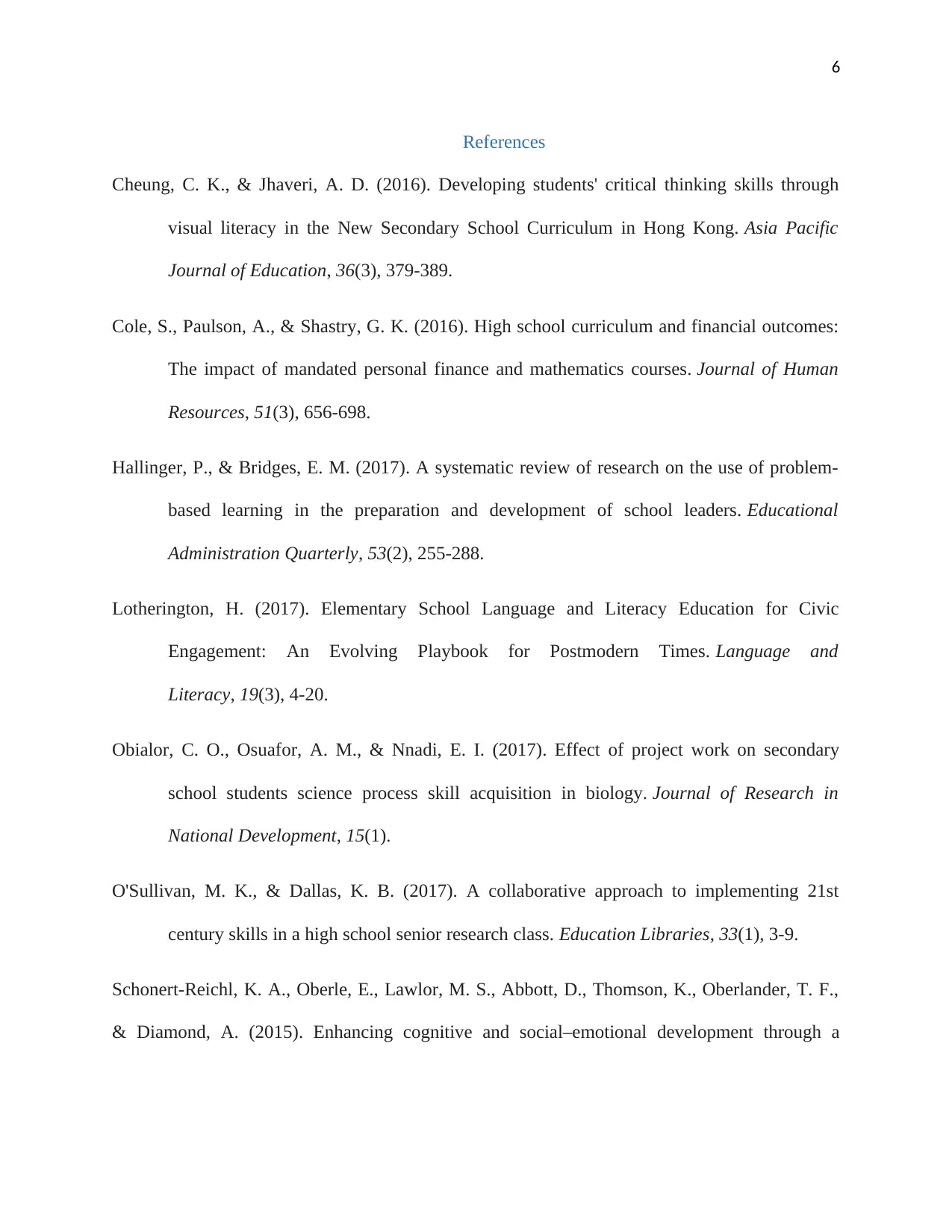
6
References
Cheung, C. K., & Jhaveri, A. D. (2016). Developing students' critical thinking skills through
visual literacy in the New Secondary School Curriculum in Hong Kong. Asia Pacific
Journal of Education, 36(3), 379-389.
Cole, S., Paulson, A., & Shastry, G. K. (2016). High school curriculum and financial outcomes:
The impact of mandated personal finance and mathematics courses. Journal of Human
Resources, 51(3), 656-698.
Hallinger, P., & Bridges, E. M. (2017). A systematic review of research on the use of problem-
based learning in the preparation and development of school leaders. Educational
Administration Quarterly, 53(2), 255-288.
Lotherington, H. (2017). Elementary School Language and Literacy Education for Civic
Engagement: An Evolving Playbook for Postmodern Times. Language and
Literacy, 19(3), 4-20.
Obialor, C. O., Osuafor, A. M., & Nnadi, E. I. (2017). Effect of project work on secondary
school students science process skill acquisition in biology. Journal of Research in
National Development, 15(1).
O'Sullivan, M. K., & Dallas, K. B. (2017). A collaborative approach to implementing 21st
century skills in a high school senior research class. Education Libraries, 33(1), 3-9.
Schonert-Reichl, K. A., Oberle, E., Lawlor, M. S., Abbott, D., Thomson, K., Oberlander, T. F.,
& Diamond, A. (2015). Enhancing cognitive and social–emotional development through a
References
Cheung, C. K., & Jhaveri, A. D. (2016). Developing students' critical thinking skills through
visual literacy in the New Secondary School Curriculum in Hong Kong. Asia Pacific
Journal of Education, 36(3), 379-389.
Cole, S., Paulson, A., & Shastry, G. K. (2016). High school curriculum and financial outcomes:
The impact of mandated personal finance and mathematics courses. Journal of Human
Resources, 51(3), 656-698.
Hallinger, P., & Bridges, E. M. (2017). A systematic review of research on the use of problem-
based learning in the preparation and development of school leaders. Educational
Administration Quarterly, 53(2), 255-288.
Lotherington, H. (2017). Elementary School Language and Literacy Education for Civic
Engagement: An Evolving Playbook for Postmodern Times. Language and
Literacy, 19(3), 4-20.
Obialor, C. O., Osuafor, A. M., & Nnadi, E. I. (2017). Effect of project work on secondary
school students science process skill acquisition in biology. Journal of Research in
National Development, 15(1).
O'Sullivan, M. K., & Dallas, K. B. (2017). A collaborative approach to implementing 21st
century skills in a high school senior research class. Education Libraries, 33(1), 3-9.
Schonert-Reichl, K. A., Oberle, E., Lawlor, M. S., Abbott, D., Thomson, K., Oberlander, T. F.,
& Diamond, A. (2015). Enhancing cognitive and social–emotional development through a
Paraphrase This Document
Need a fresh take? Get an instant paraphrase of this document with our AI Paraphraser
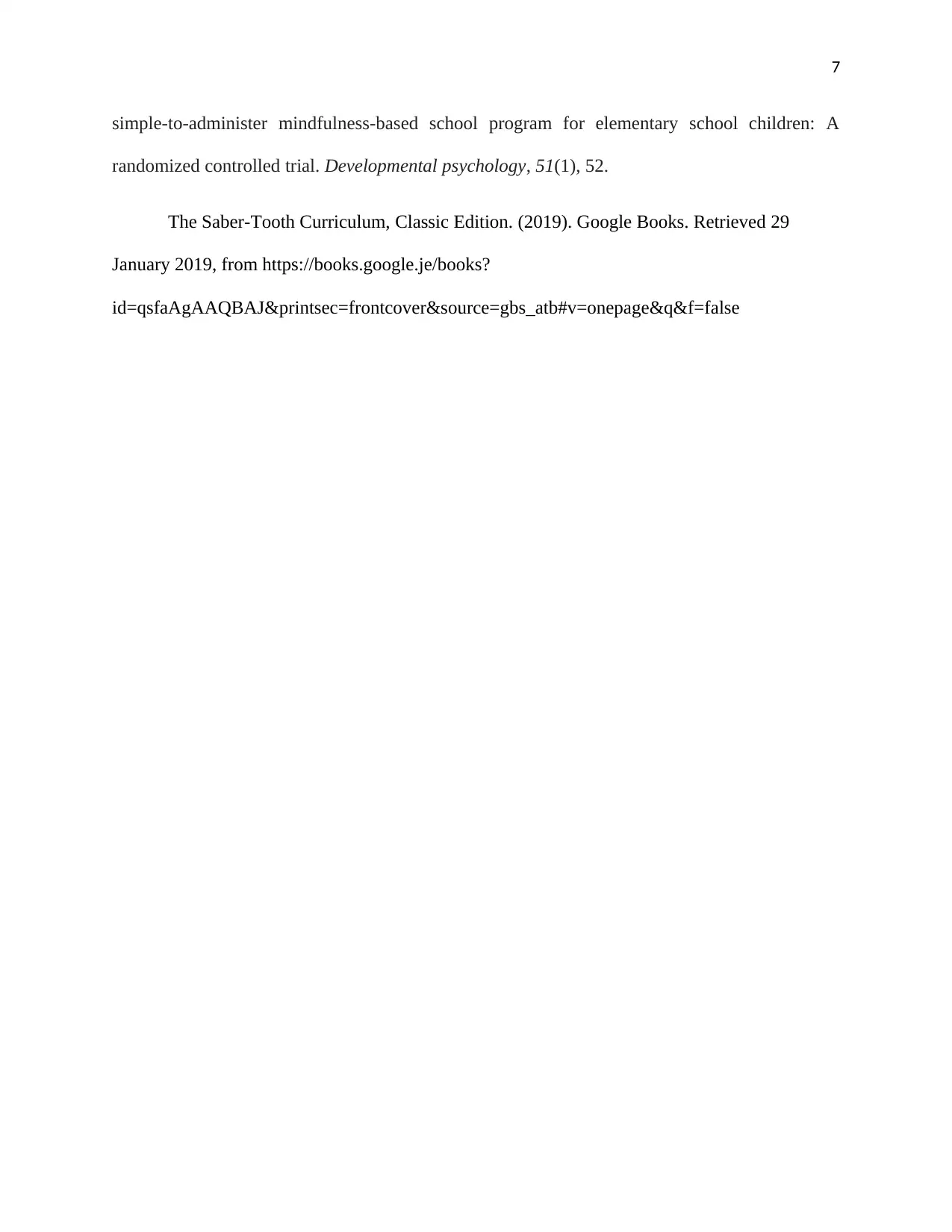
7
simple-to-administer mindfulness-based school program for elementary school children: A
randomized controlled trial. Developmental psychology, 51(1), 52.
The Saber-Tooth Curriculum, Classic Edition. (2019). Google Books. Retrieved 29
January 2019, from https://books.google.je/books?
id=qsfaAgAAQBAJ&printsec=frontcover&source=gbs_atb#v=onepage&q&f=false
simple-to-administer mindfulness-based school program for elementary school children: A
randomized controlled trial. Developmental psychology, 51(1), 52.
The Saber-Tooth Curriculum, Classic Edition. (2019). Google Books. Retrieved 29
January 2019, from https://books.google.je/books?
id=qsfaAgAAQBAJ&printsec=frontcover&source=gbs_atb#v=onepage&q&f=false
1 out of 8
Related Documents
Your All-in-One AI-Powered Toolkit for Academic Success.
+13062052269
info@desklib.com
Available 24*7 on WhatsApp / Email
![[object Object]](/_next/static/media/star-bottom.7253800d.svg)
Unlock your academic potential
Copyright © 2020–2025 A2Z Services. All Rights Reserved. Developed and managed by ZUCOL.





